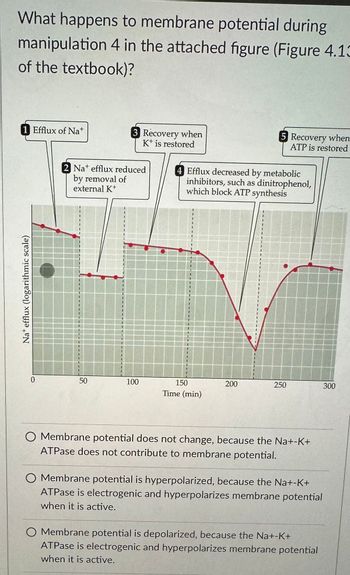
Human Anatomy & Physiology (11th Edition)
11th Edition
ISBN: 9780134580999
Author: Elaine N. Marieb, Katja N. Hoehn
Publisher: PEARSON
expand_more
expand_more
format_list_bulleted
Question

Transcribed Image Text:What happens to membrane potential during
manipulation 4 in the attached figure (Figure 4.13
of the textbook)?
1 Efflux of Nat
Nat efflux (logarithmic scale)
0
3 Recovery when
K+ is restored
2 Nat efflux reduced
by removal of
external K
50
100
4 Efflux decreased by metabolic
inhibitors, such as dinitrophenol,
which block ATP synthesis
150
Time (min)
200
5 Recovery when
ATP is restored
"
I
250
TATI
122
O Membrane potential does not change, because the Na+-K+
ATPase does not contribute to membrane potential.
O Membrane potential is hyperpolarized, because the Na+-K+
ATPase is electrogenic and hyperpolarizes membrane potential
when it is active.
O Membrane potential is depolarized, because the Na+-K+
ATPase is electrogenic and hyperpolarizes membrane potential
when it is active.
300
SAVE
AI-Generated Solution
info
AI-generated content may present inaccurate or offensive content that does not represent bartleby’s views.
Unlock instant AI solutions
Tap the button
to generate a solution
to generate a solution
Click the button to generate
a solution
a solution
Knowledge Booster
Learn more about
Need a deep-dive on the concept behind this application? Look no further. Learn more about this topic, biology and related others by exploring similar questions and additional content below.Similar questions
- Not too sure if my answer is correct.arrow_forwardWhat is an average range of millivolt difference between resting membrane potential and threshold potential? 150-300mV 1-2mV 0.005-500mV 15-30mVarrow_forwardSteady state vs burst activity – why is aerobic better for steady state and anaerobic better for burstarrow_forward
- If a skeletal muscle has depleted its stores of ATP how will the altered transport properties of the following transporters affect cytosolic ion concentrations (increase, decrease, no change) relative to normal? Skeletal Muscle Cell With Depleted ATP Stores Ion transporter Cytosolic K+ Cytosolic Na+ Cytosolic Ca2+ NKA NCX SERCAarrow_forwardPlease label E,G,H-I and state function thanksarrow_forward(Short Answer - 8 Sentences Max) The sodium-potassium pump maintains the electrochemical gradient across the membrane. Describe and explain how this process occurs.arrow_forward
- Key matching termsarrow_forwardOptions for blank one= positive or neg Blank to= into or out of Blank three= negative or positive Blank 4= into or out of Blank 5= equal to or greater thann or less than Blank 6= more negative than or les positive than or more positive then or less negative thenarrow_forwardI need help pleaearrow_forward
arrow_back_ios
SEE MORE QUESTIONS
arrow_forward_ios
Recommended textbooks for you
 Human Anatomy & Physiology (11th Edition)BiologyISBN:9780134580999Author:Elaine N. Marieb, Katja N. HoehnPublisher:PEARSON
Human Anatomy & Physiology (11th Edition)BiologyISBN:9780134580999Author:Elaine N. Marieb, Katja N. HoehnPublisher:PEARSON Biology 2eBiologyISBN:9781947172517Author:Matthew Douglas, Jung Choi, Mary Ann ClarkPublisher:OpenStax
Biology 2eBiologyISBN:9781947172517Author:Matthew Douglas, Jung Choi, Mary Ann ClarkPublisher:OpenStax Anatomy & PhysiologyBiologyISBN:9781259398629Author:McKinley, Michael P., O'loughlin, Valerie Dean, Bidle, Theresa StouterPublisher:Mcgraw Hill Education,
Anatomy & PhysiologyBiologyISBN:9781259398629Author:McKinley, Michael P., O'loughlin, Valerie Dean, Bidle, Theresa StouterPublisher:Mcgraw Hill Education, Molecular Biology of the Cell (Sixth Edition)BiologyISBN:9780815344322Author:Bruce Alberts, Alexander D. Johnson, Julian Lewis, David Morgan, Martin Raff, Keith Roberts, Peter WalterPublisher:W. W. Norton & Company
Molecular Biology of the Cell (Sixth Edition)BiologyISBN:9780815344322Author:Bruce Alberts, Alexander D. Johnson, Julian Lewis, David Morgan, Martin Raff, Keith Roberts, Peter WalterPublisher:W. W. Norton & Company Laboratory Manual For Human Anatomy & PhysiologyBiologyISBN:9781260159363Author:Martin, Terry R., Prentice-craver, CynthiaPublisher:McGraw-Hill Publishing Co.
Laboratory Manual For Human Anatomy & PhysiologyBiologyISBN:9781260159363Author:Martin, Terry R., Prentice-craver, CynthiaPublisher:McGraw-Hill Publishing Co. Inquiry Into Life (16th Edition)BiologyISBN:9781260231700Author:Sylvia S. Mader, Michael WindelspechtPublisher:McGraw Hill Education
Inquiry Into Life (16th Edition)BiologyISBN:9781260231700Author:Sylvia S. Mader, Michael WindelspechtPublisher:McGraw Hill Education

Human Anatomy & Physiology (11th Edition)
Biology
ISBN:9780134580999
Author:Elaine N. Marieb, Katja N. Hoehn
Publisher:PEARSON

Biology 2e
Biology
ISBN:9781947172517
Author:Matthew Douglas, Jung Choi, Mary Ann Clark
Publisher:OpenStax

Anatomy & Physiology
Biology
ISBN:9781259398629
Author:McKinley, Michael P., O'loughlin, Valerie Dean, Bidle, Theresa Stouter
Publisher:Mcgraw Hill Education,

Molecular Biology of the Cell (Sixth Edition)
Biology
ISBN:9780815344322
Author:Bruce Alberts, Alexander D. Johnson, Julian Lewis, David Morgan, Martin Raff, Keith Roberts, Peter Walter
Publisher:W. W. Norton & Company

Laboratory Manual For Human Anatomy & Physiology
Biology
ISBN:9781260159363
Author:Martin, Terry R., Prentice-craver, Cynthia
Publisher:McGraw-Hill Publishing Co.

Inquiry Into Life (16th Edition)
Biology
ISBN:9781260231700
Author:Sylvia S. Mader, Michael Windelspecht
Publisher:McGraw Hill Education